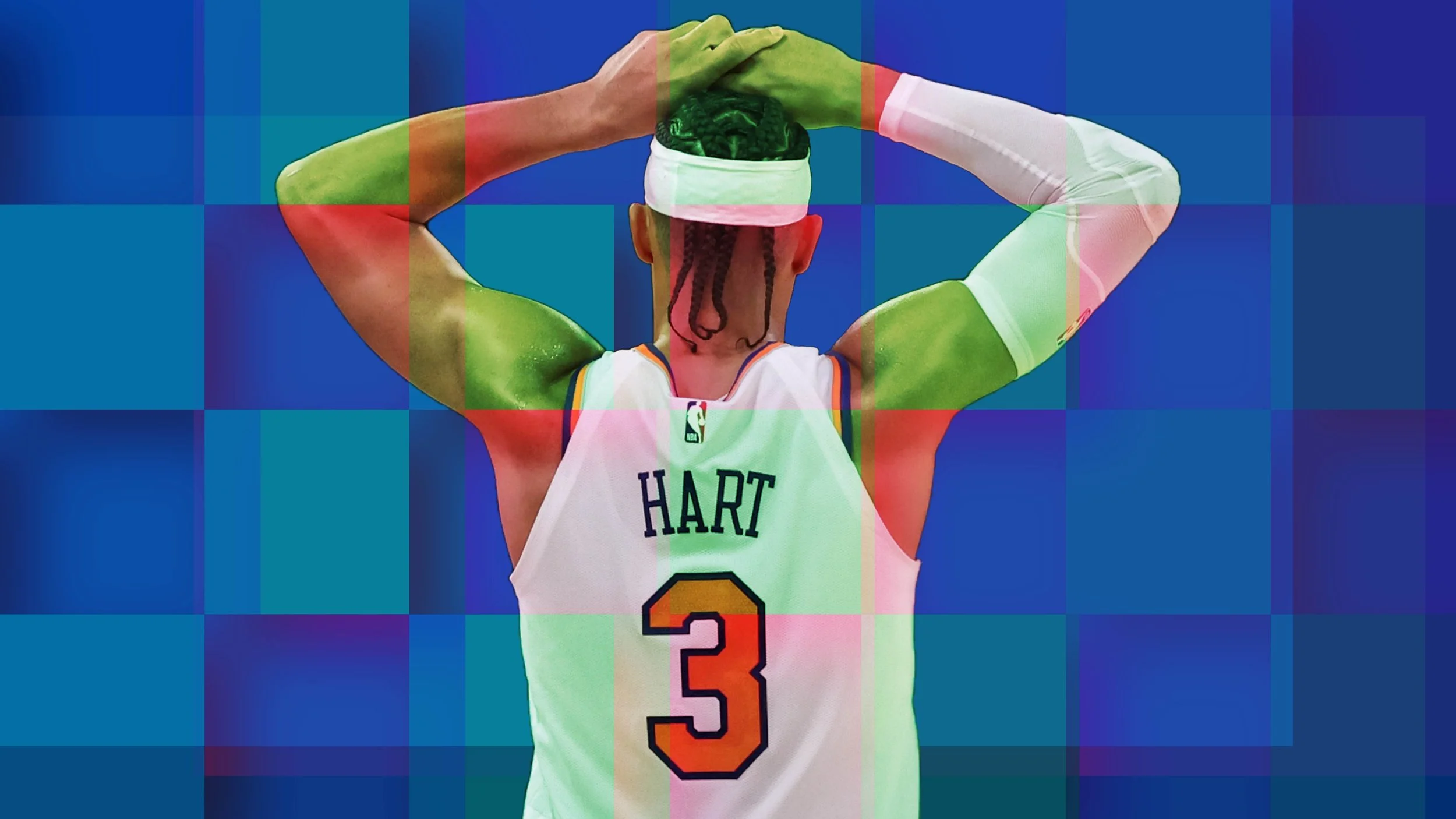Vigor, violence, persistence personified: Josh Hart does it all
The Mecca’s jack-of-all-trades’ yearly growth is a model for us all
“I’m lost” isn’t just a famous quote from Josh Hart following a disappointing prior preseason, but also how I’d answer if asked to describe this chapter of my life. Because for a second straight year, when the ball dropped on New Year’s Eve I was without a champagne glass in hand. My 16 months (and counting) of sobriety have opened up doors I’d never imagined. But the closing of others sometimes leaves me questioning my direction, the purpose of my past and the validity of my path forward.
I don’t go to bars anymore. The career I was building in hospitality and food and beverage is now just lines on a resume. Fun is more abstract than calculus. Social stereotypes often leave me struggling to think outside of the box, instilling a lack of creativity or desire to creatively adapt to life around me. In a time where (I feel) “fun” experiences aren’t about the experience itself, but rather the intoxications that take place before, during and after, I’m questioning my choice to be sober. No, it’s not that I’m going to drink again – not today, and probably not tomorrow (we don’t like to get ahead of ourselves in recovery).
But I struggle with the idea that life today is what life will be six months from now, a year from now, etc., all while understanding that my circumstances play a part in that. I’ve been in the same home for 10 months straight, the same rural Georgia town for 16. My time sober has featured work across a variety of planes: covering MLB, the NBA and NFL; serving as a ranch hand on a cattle farm; overseeing distribution in a cornmeal plant. I’ve seen people come and go, watched from afar and up close as life was revamped for some, snatched from others. There are times where I feel like Red Skull in Infinity War: stagnant, an unfulfilled bystander serving witness to the journeys of others.
Which brings me to Hart, in the middle of a career-best season eight years in the making. His triple-double two weeks ago in a win over the Philadelphia 76ers (10 points, 17 rebounds – five offensive – and 12 assists, plus four steals) inspired me to flesh out these thoughts. I wondered how many players had ever put up numbers like that – and how many at 6-foot-4 or shorter. The answer was nearly the same to both.
Hart’s the only player to record that line this season. Lafayette “Fat” Lever (6-foot-3) is the only other player Hart’s size or shorter who has, in a tale-of-the-times 99-81 Nuggets’ win in 1988. Hart now has a dozen triple-doubles after his latest against the Sacramento Kings, his sixth this season. New York is 11-1 when Hart puts on his best Russell Westbrook impression. (Ed. note: It’s not a great impression; Hart can shoot) The lone loss came last February to the Dallas Mavericks, in a game without all of OG Anunoby, Jalen Brunson and Julius Randle. No wonder.
I referenced Westbrook – as opposed to Oscar Robertson or other famed stat-sheet stuffers – despite the connotation surrounding his “style” of triple-doubles, because there are overarching, overwhelming parallels: the 6-foot-4 Westbrook has won nearly 75 percent of his career triple-doubles (149-53). Moreover, he’s been consistent in those games, Father Time’s hold on him the last few years notwithstanding, at least in the only way that matters to him: his way. Wesbrook took a lot of flack during his famed MVP season, when he averaged a triple-double. As someone who watched something like 75% of the Thunder’s games that year, trust when I tell you he never wavered. Russ was Russ, games 1 through 82. Some of Hart’s better moments in New York remind me a lot of that Brodie era: the way he plunges into the post out of nowhere and crashes the glass, his bounding breaks in transition, and of course his uncensored personality – on and off the floor.
But before he was competing like a former MVP for a Knicks team on the verge of a third straight postseason, Hart was actually lost. Drafted by the Los Angeles Lakers in 2017, he spent two middling years in Hollywood before being shipped out in the Anthony Davis trade package that netted the league’s most critiqued championship and an absolute hellscape of an aftermath. (Seriously, how are the last several seasons of basketball the Lakers’ best efforts at winning LeBron James’ sixth title? Can you imagine things playing out the same in New York, with the Knicks? Sheesh.)
Two seasons with a new team in New Orleans netted Hart the same result: another trade to a lowly Western Conference underachiever. He played the most convincing basketball of his career (to that point) in Portland, averaging career-highs across the board and a 33 percent clip from three. After five-and-a-half seasons with three teams and a 189-225 record, Hart’s path brought him to Madison Square Garden.
He’s since played two and a half seasons in New York, all for one coach, with a team that’s 94-56 in the regular season since. Leon Rose’s trade for Hart, if not the brain that cooked up the deal, should be scientifically studied one day. Cam Reddish and the lesser Murray brother couldn’t provide a tenth of this impact if they did the fusion dance and combined all their “powers.” And don’t forget Tom Thibodeau’s role in this story, either.
Following an offseason where the Knicks added Mikal Bridges and Karl Anthony Towns, career 37- and 40-percent 3-point shooters, preseason hype was centered on the five-out offense and how it’d benefit budding superstar Brunson. And while Brunson’s inevitability has looked no less escapable, it’s Hart who’s been the major benefactor. How did we overlook what space could do for a player who utilizes it like a running back? Or was that just me?
Hart’s averaging 13.9 points, 9.8 rebounds, 5.7 assists, 1.5 steals and a three per game this season. That’s been done seven times in NBA history, by four players: Hart, Westbrook, Nikola Jokić and Larry Bird. So far this season Hart ranks seventh in steals and defensive rebounds, ninth in total rebounds and 15th in assists. Reminder: he’s the league’s 96th-highest paid player at $18 million. Bojan Bogdanović makes more!
I was told once that the best sign of what our future holds can be found in the decisions we make today. Hart’s today is only possible because of a series of decisions he made in those stops with the Blazers, Lakers, Pelicans, even the Knicks, through waves of change. The most pivotal among them, I’ve no doubt, was a steadfast resolve in being himself. So don’t let this season surprise you. The road he’s on today is the same one he took to get here.
I don’t know what I want out of life yet. I’ve only just begun living, truthfully. But I know who I am. I’m in touch with my baseline. And whether I’m in my Los Angeles, New Orleans, or Portland era, I believe the road I’m on today will do the same for me.
In 152 games with New York, Josh Hart has bridged the gap from supporting cast member to could-be should-be All-Star and Most Improved Player candidate while playing next to two All-Stars in their own right in his career-best year. Self-belief is a powerful thing. Perhaps the most powerful. But I found a synonymous idea that might be more fitting for Hart: self-efficacy.
Canadian-American psychologist Albert Bandura defined self-efficacy as “an individual's belief in [their] capacity to execute behaviors necessary to produce specific performance attainments.” Since landing in New York, Hart’s played the role of reserve and starter, broken teams with his rebounding, chased loose balls with vigor and violence and paralyzed postseason foes with clutch buckets. The thought of anyone else wearing number three for the Knicks has become sacrilegious in my mind — maybe yours, too. (Ed. note: There’s one generation of Knicks fans who’ll swear #3 is and always will be John Starks, another that claims Stephon Marbury, etc.)
This is where Hart was meant to be. He is New York basketball. And his career season? Proof, meet pudding.


